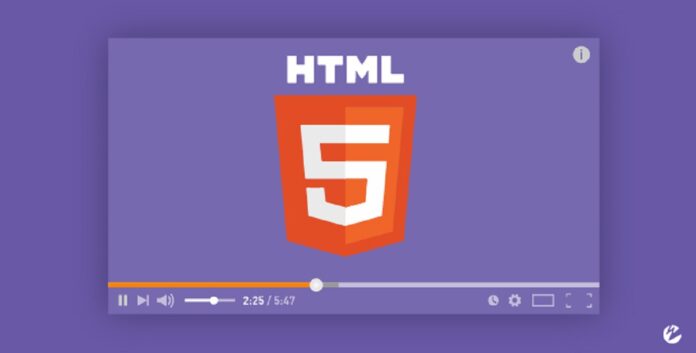HTML5 video accessibility may be the future, but it certainly isn’t ready to be the central platform of the present. Any severe game developer (especially in the web/mobile field) must discover a new language to prepare for that future. Still, numerous obstacles must be addressed before HTML5 video accessibility saves us all.
What Is HTML5 video accessibility?
We all know that HTML video accessibility is the coding language for the visual aspects of the web. Since the original version of HTML was created by Tim Berners-Lee at CERN around 20 years ago, the dialect has undergone several updates and iterations.
The most critical current instance is the incapability to integrate video into HTML logically. As an outcome, several businesses have developed unique formats and diverse methods (ranging from WMV to MP4) to play back videos. All the external plug-ins (such as Adobe Flash) required to run these formats are risky and annoying since you must install, download, trust, and continuously update them.
Challenges and Critical Takeaways for HTML video accessibility
To help you evade challenges when you’re creating HTML5 video accessibility, we’re going to work through some of the potential snags, the most crucial considerations, and, most importantly, their solutions.
Challenge 1: Media format issues
Modern technology is plug-in free, which allows more excellent mobile learning experiences but can cause problems with media formats, as various browsers use, unlike formats.
According to Adobe, since you can embed video and audio directly in the HTML5 video accessibility, you can run content on mobile policies, such as mobile phones and tablets, without trusting applications or third-party plug-ins.
This is a severe hurdle cleared since several people want to view e-learning content on a mobile phone rather than on a laptop or computer. It implies it is wise to use a link of formats to accommodate different internet connections and, crucially, different browsers.
A few additional minutes setting up formats for various browsers has paid bonuses and banned potential prevention from learners. A simple way to evade format issues when generating your elearning courses is to practice a tool with a constructed HTML player (such as Elucidat, which uses MediaElement.js); it works with all the leading browsers (most old browsers, too) and needs only a sole upload.
Key takeaway: Devote tools that take care of training for you and use a well-matched video player with several browsers.
Challenge 2: Browser compatibility
HTML5 video accessibility rests upon your browser’s compatibility. Now all you want is an HTML5-ready browser, which is easy – go for Firefox, IE 10-11, or Chrome.
Using cloud-based authoring tools and having a great browser– such as Elucidat– will stop you from blockage of your computer with software.
Several organizations insist on older (non-HTML5) browsers for compliance and safety when producing desktop-centric paths. This makes it essential to withdraw that routinely convert your HTML5 work for older browsers. Modernizr and MediaElement.js enable you to move onward with confidence.
Key takeaway: Browser compatibility for legacy and new browsers has infinitely enhanced and endures to advance – recollect to offer substitutes for older browsers.
Challenge 3: HTML5 code is viewable
With HTML5 video accessibility, the employer’s computer extracts the files. These funds, you can view HTML, CSS, and JavaScript. This is ideal if you want to see how the big boys work and learn to code, but not so great when shielding your intellectual property.
To combat code copying, some designers “minify” their work, eliminating all redundant characters from the base code without altering its functionality, making it challenging for content to imitate easily.
This is heavy-handed and quite time-consuming. A great practice is to use both learning management systems and authoring software, which lets you protect your content and control who can view your projects.
Key takeaway: Invest in tools that allow you to restrict access to materials and take steps to protect your work.
Challenge 4: HTML5 standards
As a developing technology, HTML5 values are subject to change. Keeping up with specification changes and browser updates is a real pain, though – and it saves you from making excellent content. It would help if you influenced a tool that can inform modern technologies mechanically, as Elucidat does.
Key takeaway: HTML5 values may continue to alter – choose an autoplay video accessibility that will future-proof your work.
Challenge 5: Capability for animation
For several of us, animations are essential to creating engagement in elearning. HTML5 video accessibility doesn’t use similar Flash-based technology, and this can cause some concerns when watching animations on older browsers.
In ancient times, there weren’t various options for creating HTML5 vibrancies, but now there are some great fresh animation tools accessible and in growth. Great HTML5-based apps (such as Elucidat) have animation choices built in.
Key takeaway: There are many simple ways to convert your existing content to HTML5 and create new content.
Getting Users Without A Suitable Distribution Channel?
On the positive side, two of the domain’s most influential and largest internet companies are dead serious about HTML5 video accessibility and are loud-mouthed about the technology.
There is no uncertainty that Facebook trusts in HTML5. Even two years ago, they were eager about HTML5, rallying their developers to build the future with HTML5 and creating a dedicated blog.
With the introduction of Chromebook and Chrome OS, Google took straight action, presenting its certainty that the web is the future, with its goal being to have all running in the cloud on a clean, simple browser.
Google shaped its own Chrome Web Store for this drive, which is a stage in the correct direction, but not every publisher and developer can build their stores. Google Play and Apple’s AppStore make purchasing and discovering content pretty suitable, giving people a purpose to find what they want.
Wrapping up
HTML5 video accessibility serves more as a tallying to native development instead of substitution, letting apps benefit from traffic that cannot easily be reached via standard native applications.
While this fresh HTML iteration is intended to push the cross-platform practice to new levels, there are many obstacles to cross before an HTML5 video accessibility project can run on distinct platforms, making the work just as challenging.


